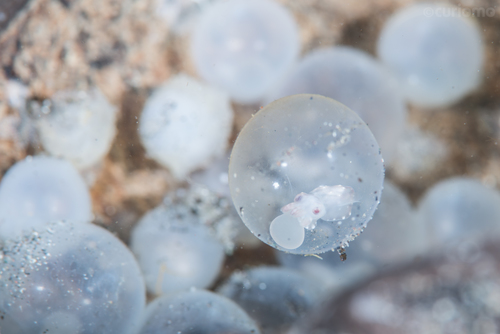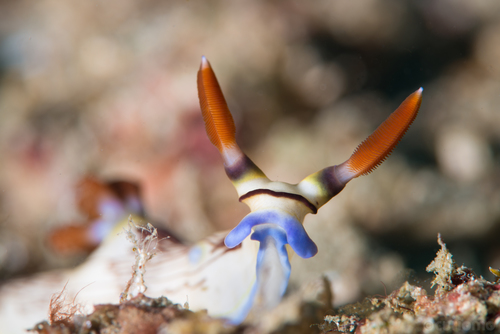
is not actually a true crab, but rather an animal that has evolved to resemble one. Sometimes natural selection can cause genetically distinct types of animals to converge upon a common (and useful) shape.

sticking out above the sand are oftentimes the only part of these animals that you'll see during the day, whereas at night these critters will come out and hunt - photo taken near Puerto Galera, Philippines

incredibly tiny, and laid by the millions in a tight spiral pattern - Raja Ampat, Indonesia

just before they hatch into larvae. Each one measures about 1mm wide by 2-3mm long. The eggs typically hatch just 4-8 days after being laid - photo taken in the Bay of Puerto Galera, Mindoro Island, Philippines

caring for his young - photo taken in the Bay of Puerto Galera, Mindoro Island, Philippines

found on the inside of a coconut husk, partially buried in the sand - photo taken at Lembeh Strait, Indonesia

those tiny eggs hatch and eventually grow into this beauty - Lembeh Strait, Indonesia

more like a handshake than a steamy encounter, these two nudibranchs are shown mating in this photo, via the "tubes" joining midway between their bodies. Each nudibranch individual is both male and female. After exchanging genetic material, both of these nudibranchs will go lay down its own spiral colony of fertilized eggs - Raja Ampat, West Papua, Indonesia

one of the smallest fish you'll find in the sea, these beautiful and shy creatures live in sea fans, and blend in extremely well with their surroundings - photo taken at Pemuteran, Bali, Indonesia

If you look closely you can see this Bubble Coral Shrimp’s eggs (and other bodily organs) right through its translucent body - photo taken near Sabang, Mindoro Island, Philippines

seen up close. He needs a visit to the dentist - photo taken at Misool, Arafura Sea, West Papua

swims right above a small sponge that he can use as a place to hide - Raja Ampat, Indonesia

make thier homes in the underside of a Feather Star (sometimes called a Crinoid) - Bunaken Island, North Sulawesi, Indonesia

are club shaped antennae-like structures protruding from the heads of sea slugs, and are used to detect chemical scents and tastes in the water, since these beautiful animals have no eyes - photo taken in the Philippines

is a type of coral that moves its appendages like grasping claws to capture plankton and other small foods floating by in the water (ID credit: Lauren Wilson)

are another type of resident in a Crinoid (feather star), and are almost always color coordinated with their hosts

A closeup of a brittle star, shot in Bonaire (Dutch Antilles). Also called serpent stars, they and their sea star brethren belong to the phylum echinodermata. The thing that makes the brittle star unusual (and sometimes creepy) is that instead of moving around almost imperceptibly slowly via the small tubules underneath most sea stars, these guys use their five (pentaradial) arms to crawl around quite quickly. Sometimes the entire seafloor is covered in them, squirming around each other.



